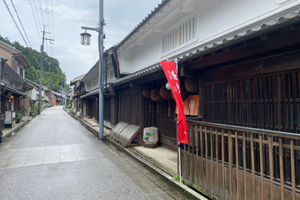
Kubo Honke Shuzo
久保本家酒造
Uda, Nara
This family run brewery has over 300 years of history and focuses on Kimoto sake brewing as well as aged sakes. Their sakes are incredibly smooth and often best when drunk warm, but are also complex demanding, and thus perhaps less suited for sake novices.
| Main brands | Kimoto No Dobu, Suiryu |
|---|---|
| Founded | 1702 |
| Generation | 11 |
| No of Employees | 9 |
| Annual Production | 500 Koku |
| Website | https://kubohonke.com/ |
People
People behind the scenes

Katsunori Kato

Junpei Kubo
Biography
Interview with the Toji
We speak with Kubo-san about the history of Nara, his brewery, and what it takes to compete and differentiate yourself in a competitive and declining industry.
Read the full interview here.
History

Uda, where the Kubo Honke Brewery is located, is known as a place of scenic beauty loved by the poets of the Manyoshu (the oldest collection of Japanese poetry, dating back to the 8th century). It is also close to the capital of Asuka, which is the time period when Japan started to be referred to as “Nihon” (日本). In the Middle Ages, it was also a castle town under the control of the descendants of Oda Nobunaga. Later, in the early modern period, the town was a busy place where people and goods came and went as a post town connecting to Kumano Kodo and Ise Kaido.
Around this time, Kanbei Kubo, the first generation, came out from the mountains deep in Yoshino and started brewing sake at the present location in the Genroku era of Edo with the ambition to make a name for himself in the then greater region of Uda. Since then, the Kubo family has been brewing sake for over 300 years.

Kubo Honke’s stylistic sake lays its foundation on the traditional Kimoto brewing method, which emphasizes umami and lightness at the same time as providing mild aromas. It has a refreshing acidity and a solid core of flavor that goes along with almost any type of food. The sharpness of full fermentation and the depth of flavor of several years of aging make Kubo Honke’s sake special.
At Kubo Honke, the steamed rice and koji are made a little harder when compared to other breweries. The yeast population is carefully nurtured in the open natural environment. By doing so the Koji mold reaches a strong saccharification power and the yeast has a strong fermentation power for the parallel fermentation process. The aim is to create a sake with a firm body of flavor that is closed off by sharp acidity.
Products
Visit



Mount Yoshino (吉野山)
This mountain is especially renowned for its beautiful cherry blossoms in the spring.
Find out more...
Old town of Uda-Matsuyama (宇陀松山の古い町並み)
The old Japanese townscape of Uda-Matsuyama great for a stroll.
Find out more...



